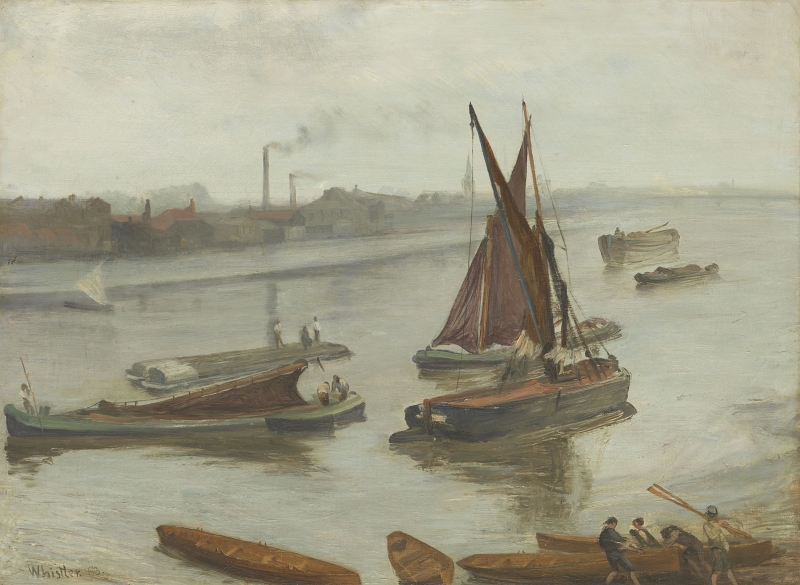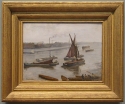Composition
Kimberley Muir noted a number of early compositional changes revealed by recent visual and technical analysis. Originally there may have been a large sailing barge at mid-left on the river, and a smaller boat at lower right, as well as several additional figures to right of centre, beside the beached rowing boats. 1
Technique
Grey and Silver: Old Battersea Reach is very freely painted, with thin paint the consistency of rich cream, in fluid, bold brushstrokes in the foreground, and careful, smaller brushstrokes on the buildings in the distance. Stephanie L. Strother notes that Whistler's technique had changed considerably over the past year: 'Whistler’s facture in Grey and Silver: Old Battersea Reach is thinner and more delicate, although still energetic. ' 2
According to Kimberley Muir in her analysis of Whistler's materials, he used a relatively coarse plain weave canvas from Winsor & Newton, commercially prepared with an off-white ground applied in two layers. Whistler's paints included lead white, red and yellow iron oxide or earth pigments, umber, vermilion, cobalt blue, viridian, and bone black, and isolated patches of red lake pigments. His brushes ranged from 5 to 20 mm in width, with smaller, pointed, brushes for details, and occasionally a knife to apply or remove paint. Muir also discusses Whistler's painting methods.
'It is possible that Whistler scraped or rubbed out parts of the initial lay-in, but for the most part, he simply painted over it ... with the broad brushstrokes used to paint the water. When beginning the final composition ... the figures, … [were] quickly blocked in with thinly applied dark-brown paint.
... Whistler used a variety of paint consistencies and application techniques ... He created low texture in the early stages of painting through distinct brush marking and scraping in the sky and water. In the lower … corners the brushwork is quite open, with areas of the ground exposed, and some of the lower paint layers have the appearance of having been smoothed or smeared on with a knife. Much of the brushwork consists of paste-consistency paint either blended in smooth layers or brushed on in distinct strokes with stiff brush marks. Some of the figures were created with quick wet-in-wet, low-impasto brushstrokes. Whistler combined these ... with areas of very thin, fluid paint application and more of a dry-brush technique. The paint used to create the shadow on the water of the front sailboat was very fluid, and some areas look like they were smoothed with a rigid tool or possibly even a fingertip. The artist scraped into the paint using a pointed tool ... to break up the solid, dark-brown shadows of the two sailboats. Areas of wet-over-dry paint buildup suggest that the painting was executed in more than one painting session.' 3
Conservation History
It seems, surprisingly, to have been one of the few paintings NOT conserved and revarnished at the time of the Goupil exhibition in 1892!
In her detailed report on the conservation history and condition of the painting, Kimberley Muir in the Art Institute of Chicago online catalogue includes the following comments:
'Overall, the painting is in relatively good condition. There is old damage near the center of the canvas, consisting of two vertical tears—one approximately 6 cm in length, the other around 2.5 cm—with associated loss and abrasion of the adjacent paint. ... The surface has a semigloss sheen, somewhat uneven in appearance, especially in the region of the retouched damages.
… there are small, scattered paint losses, mostly around the edges of the painting. … The painting has a fairly pronounced network of cracks in some areas. There are diagonal stress cracks at the upper corners, drying cracks … in the buildings and the thicker passages of the sky and the boats.' 4
Frame
- 1867: Style unknown, whereabouts unknown.
- 1892: Grau-Whistler frame, English, possibly by F. H. Grau, now on the painting. 5
A Goupil Gallery account from May 1892, of frame work done in preparation for Whistler’s retrospective, shows that the owner, Madame Coronio, had ‘paid’ and that a ‘new one [frame] was cut down’; however, this note was then crossed out. 6
The painting seems to have been reframed before it went to America in 1892. D. C. Thomson mentioned the frame, writing, 'in June 18 - we c[redi]ted you with £5 for the frame on the picture sold to Mr P. Palmer.' 7
The painting is now in a Grau frame, possibly made by Frederick Henry Grau (1859-1892) in 1892.
Notes:
1: Kimberley Muir, 'Cat. 7 Grey and Silver: Old Battersea Reach, 1863: Technical Summary,' in Whistler Paintings and Drawings at the Art Institute of Chicago, The Art Institute of Chicago, 2020, URL.
2: Strother, Stephanie L., 'Cat. 7 Grey and Silver: Old Battersea Reach, 1863: Curatorial Entry', in Whistler Paintings and Drawings at the Art Institute of Chicago, The Art Institute of Chicago, 2020, para 5 URL.
5: Dr Sarah L. Parkerson Day, Report on frames, 2017; see also Parkerson 2007 [more] .
Last updated: 5th June 2021 by Margaret








